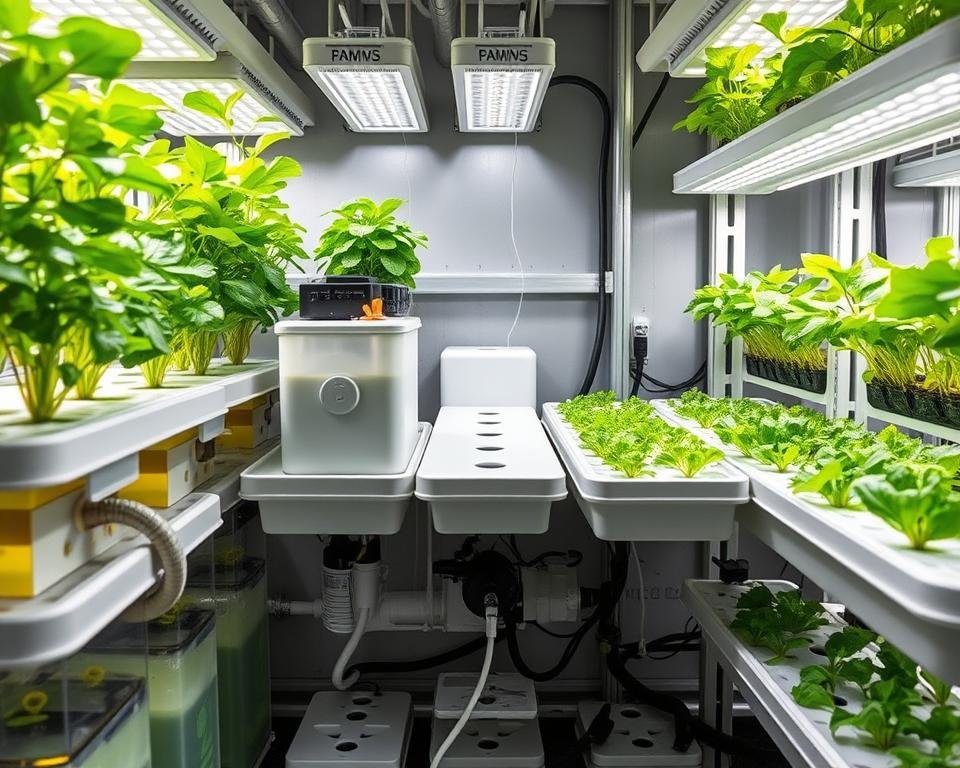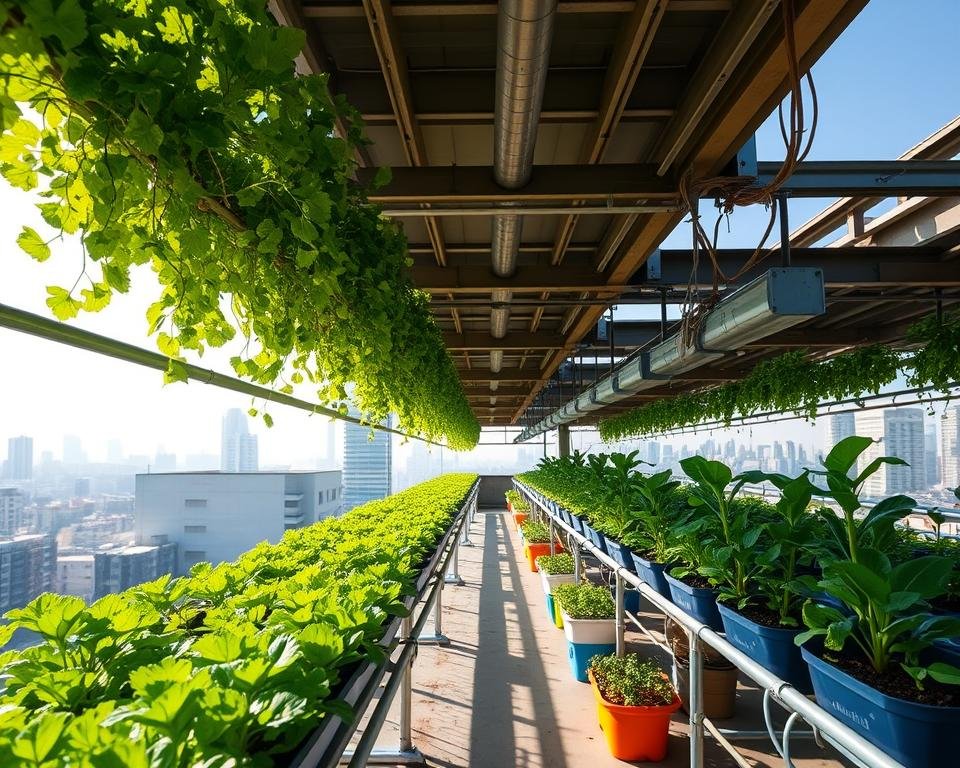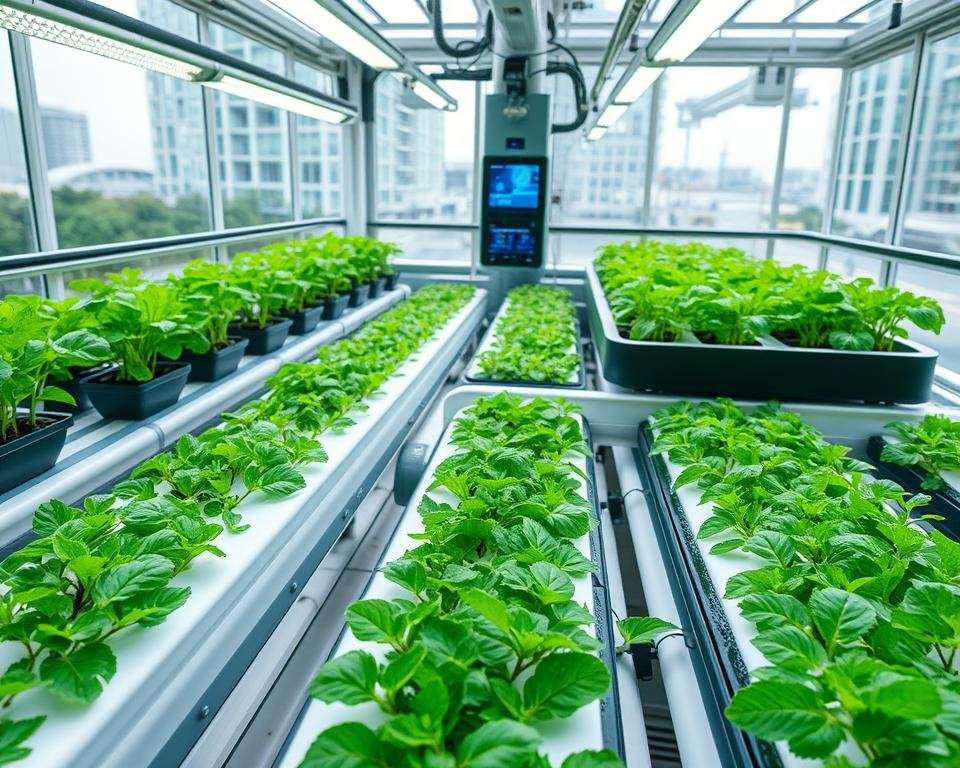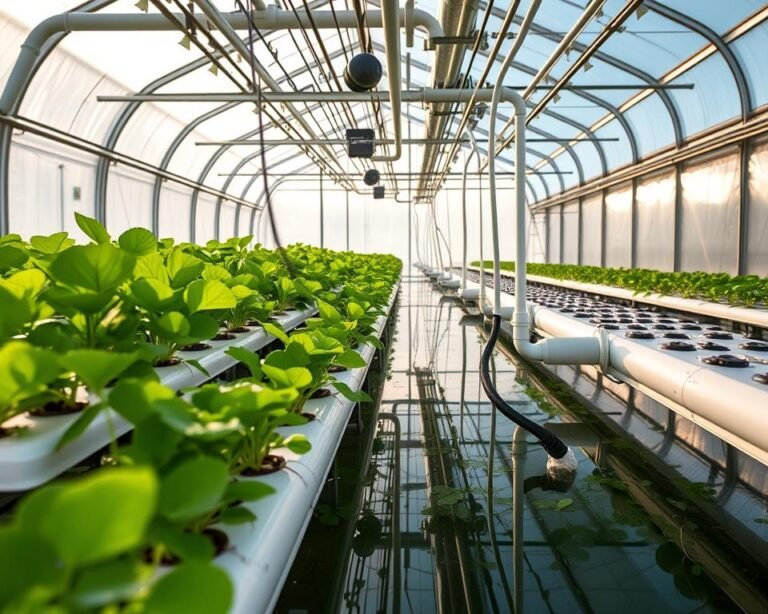Small-Scale Hydroponic Farms: Inspiring Case Studies for Success
In a world where cities are getting bigger and farming is getting harder, small hydroponic farms are a bright spot. Your kitchen, rooftop, or small backyard can turn into a place where food grows in amazing ways. It’s a way to grow food that’s different from old-school farming.
As cities expand and land for farming gets smaller, hydroponic farming shows a new way to grow food. These small farms use tech and creativity to beat old farming problems. They offer a green way to grow food in tight spaces.
Think about growing over 25 pounds of fresh food every 28 days in just 10 square feet. Hydroponics make this happen by controlling the environment, using up to 90% less water, and growing more food than traditional farming.
Key Takeaways
- Small-scale hydroponic farms can produce substantial food yields in minimal space
- Hydroponic systems use 90% less water than traditional soil farming
- Indoor hydroponic gardens enable year-round food production
- Technology allows precise control of growing conditions
- Urban spaces can be transformed into productive agricultural environments
Understanding the Revolution in Urban Agriculture
Urban agriculture is changing how we grow food. New soilless farming technologies are making farming better. They solve old problems in new ways.
Today’s urban farming uses the latest tech for sustainable food. Vertical farming and hydroponics lead this change. They help grow food in small spaces.
The Rise of Soilless Farming Technology
Soilless farming is a big leap forward. It uses advanced hydroponics to grow crops efficiently:
- Reduce water usage by up to 95%
- Optimize space through vertical farming techniques
- Eliminate traditional soil-based limitations
- Enable year-round crop production
Benefits of Small-Scale Hydroponic Systems
Small hydroponic systems have big benefits for city farmers:
- Water Conservation: Precision irrigation saves water
- Space Efficiency: Grow more in small urban areas
- Controlled Environment: Keep crops safe from bad weather
“Technology is revolutionizing agriculture, making food production more sustainable and accessible than ever before.” – Agricultural Innovation Expert
Current Market Trends and Opportunities
The urban agriculture market is growing fast. Digital tools and smart tech help farmers:
- Increase productivity with data
- Reduce harm to the environment
- Build sustainable local food systems
By using hydroponics and vertical farming, you join a big change in farming. The future of farming is urban, efficient, and tech-savvy.
Essential Components of Successful Hydroponic Setups
To start a profitable small hydroponic setup, you need to know the key parts. Controlled environment agriculture is a great chance for beginners to change their farming ways.

When you design your hydroponic system, several important parts are crucial for success:
- System Type Selection
- Nutrient Management
- Environmental Control
- Space Optimization
For those new to hydroponics, picking the right system is very important. There are many hydroponic methods to choose from:
- Nutrient Film Technique (NFT)
- Deep Water Culture (DWC)
- Ebb and Flow Systems
- Vertical Growing Configurations
“Success in hydroponics comes from understanding your system’s unique requirements and maintaining consistent environmental conditions.” – Hydroponic Expert
Your setup’s success depends on careful management. Here are key things to consider:
- Water Quality: pH levels between 5.5-6.5
- Temperature Control: Keep 65-75°F
- Humidity Range: Keep between 50-70%
- Nutrient Concentration: Regular monitoring essential
Automation can make your hydroponic farm more efficient. Modern tools help track your crops, improve nutrient delivery, and cut down on manual work.
Starting small is a good idea. Microgreens or small systems are great for learning before you grow bigger.
Small-Scale Hydroponic Farms: From Concept to Reality
Turning your dream of indoor gardening into a real sustainable food source needs careful planning. Micro farms are changing urban farming, making it possible to grow fresh food in small spaces.
Start by learning the basics and strategies for small hydroponic systems. With the agricultural innovation landscape changing fast, it’s a great time to dive into these new opportunities.
Planning Your Hydroponic Operation
Good hydroponic farming starts with solid planning. Think about these important points:
- Space and light you have
- How much money you need to start
- The right crops for your setup
- Your long-term goals for sustainability
Space Optimization Strategies
To grow more, use your space wisely. Vertical farming techniques can greatly boost your output:
| Strategy | Potential Yield Increase |
|---|---|
| Vertical Shelving | Up to 300% more growing area |
| Multi-Level Systems | 400% increased production |
| Compact Grow Towers | 250% space efficiency |
Resource Management Techniques
“Efficiency is the key to sustainable urban agriculture.” – Modern Farming Innovator
Smart resource use can change your micro farm. Indoor hydroponics use 80-90% less water than traditional farming. This makes them a green choice for growing food.
Key steps for better resource use include:
- Managing nutrient solutions carefully
- Using energy-saving lights
- Automating monitoring
- Reducing waste
By using these new methods, you can make a productive hydroponic farm. It will grow a lot of food while being kind to the environment.
Case Study: Mumbai Rooftop Success Story

Urban agriculture is changing the game for city folks wanting fresh, green food. In Mumbai, people are turning their rooftops into gardens using hydroponics.
Riya, a tech worker, made her rooftop a lush hydroponic garden. It shows how even small spaces can grow a lot of food. She proved that city folks can get around space and food quality issues.
“Innovation begins when you see potential where others see constraints.”
Her garden had a few key things:
- Nutrient Film Technique (NFT) system
- Leafy greens for crops
- Adapted to Mumbai’s weather
- Smart water and nutrient use
The outcomes were impressive. Riya’s garden gave:
- High-quality veggies all the time
- Lower grocery bills
- Better nutrition for her family
- Sparked urban farming in the community
Her story shows urban farming is more than a trend—it’s a green way of life.
Technology Integration and Smart Farming Solutions
The world of controlled environment agriculture is changing fast. It’s now easier for hydroponic farmers to grow crops. Smart farming solutions are making small-scale hydroponics more efficient and easy for beginners.

Today’s hydroponic systems use the latest tech to manage farms better and grow more crops. Hydroponics for beginners can now use advanced tech that was once only for big farms.
Automation Systems for Small Farms
Automated systems are changing hydroponic farming. They handle important tasks with great precision:
- Automated nutrient dosing
- pH level adjustment
- Irrigation scheduling
- Real-time environmental monitoring
Monitoring Tools and Software
Advanced software lets farmers track plant health with high accuracy. IoT devices monitor key factors in real-time:
| Monitoring Parameter | Technology Used | Precision Level |
|---|---|---|
| Water Levels | Smart Sensors | 99.5% |
| Nutrient Concentration | AI Analytics | 97.8% |
| Temperature | Thermal Imaging | 98.2% |
Climate Control Solutions
“Technology is transforming agriculture from a traditional practice to a precise, data-driven science.” – Agricultural Innovation Expert
Smart climate control tech lets hydroponic farmers create optimal growing environments. LED lighting, smart HVAC systems, and AI for maintenance are changing small-scale farming.
Using these smart farming solutions can greatly improve crop yields. It also reduces resource use and makes farming more sustainable.
Sustainable Practices and Environmental Impact
Small-scale hydroponic farms are changing the game in sustainable food production. They turn urban agriculture into something amazing. These systems offer big environmental wins, unlike traditional farming.
Your hydroponic farm can make a big difference for the planet. It does this through several key ways:
- Water conservation with up to 98% less water usage compared to traditional agriculture
- Elimination of pesticide requirements
- Minimal land use and reduced soil degradation
- Decreased food transportation emissions
Environmental impact metrics show how powerful urban agriculture can be:
| Sustainability Metric | Hydroponic Performance |
|---|---|
| Water Consumption | Up to 98% reduction |
| Carbon Footprint | Significant local emission reduction |
| Crop Yield per Square Meter | Up to 1,000 times more than traditional farming |
“Vertical farming is not just agriculture; it’s an environmental solution for future food systems.” – Agricultural Innovation Expert
By using sustainable practices in your hydroponic setup, you’re doing more than growing food. You’re helping change the environment for the better. Your small-scale farm can be a leader in efficient, eco-friendly urban agriculture.
Financial Planning and ROI Analysis
Starting a small hydroponic setup needs smart financial planning. Knowing the soilless farming market is key. By looking at costs and income, you can make your hydroponic farm a real business.
Initial Investment Considerations
Starting a hydroponic farm has several financial parts. Your first costs include:
- Equipment costs (grow lights, pumps, containers)
- Infrastructure setup
- Nutrient solutions
- Growing media
Operating Costs Breakdown
Knowing your ongoing costs is vital for successful hydroponic farming case studies. Key costs are:
| Expense Category | Estimated Monthly Cost |
|---|---|
| Electricity | $150-$300 |
| Water | $50-$100 |
| Nutrients | $100-$250 |
| Labor | $500-$1500 |
Revenue Generation Strategies
Boost your farm’s earnings with different ways to make money:
- Direct-to-consumer sales
- Local restaurant partnerships
- Farmers market presence
- Community supported agriculture (CSA) programs
“Automation technologies can help reduce labor costs and increase overall farm efficiency.”
Your hydroponic farm can make a lot of money. With good planning and smart work, you can grow a lot in a small space. The secret is knowing your market, controlling costs, and offering top-quality, eco-friendly produce.
Conclusion
Your journey into small hydroponic farms is a big step towards changing urban agriculture. Vertical farming uses up to 95% less water than old methods. It also boosts productivity and is more sustainable. These examples show how people and communities can change food production.
Technology is key in farming today. IoT lets farmers watch their crops grow with great detail. Digital tools give farmers market info in real time. Startups like FarmCrowdy help small farmers grow more and earn better.
By using hydroponics, you help the planet too. You’re not just growing food; you’re helping the environment. Urban farms can grow over 200 pounds of food a year for every 100 square feet. They also cut down on carbon emissions and make local food better.
Every small step you take counts. Whether it’s a balcony, terrace, or small urban area, your efforts matter. The future of farming is here, and it’s growing, one hydroponic farm at a time.







